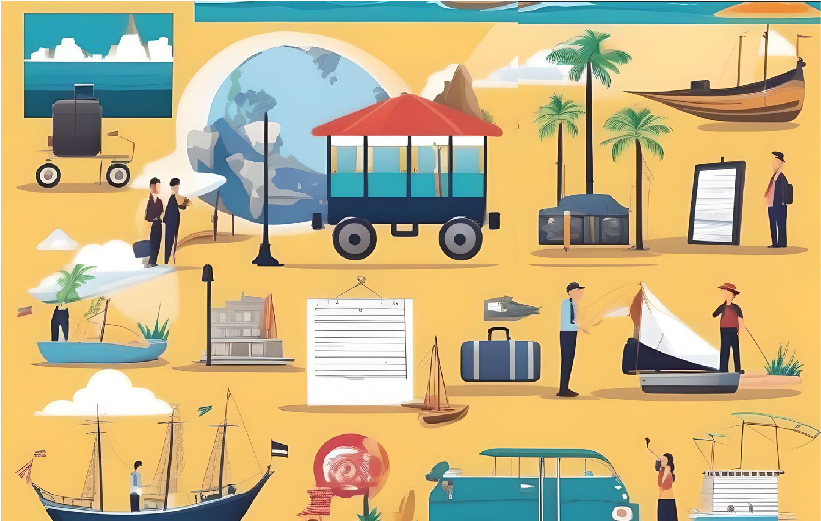
Table of Contents
Introduction
Bangladesh is nation in the process of developing. Bangladesh has maintain its progress in the development sector through appropriate or sustainable management. This progress is supported by a variety of sectors. Among them is the tourism industry. Furthermore, a number of industries, including the textile and apparel industries, agriculture, remittances, freelance work, and others, have made signficant contributions to Bangladesh’s prosperity.
The tourism industry now makes a significant contribution to development. However, the tourism industry is severely damaged by a variety of calamities. Man-made disasters include the collapse of textile factories and building fires. The natural disasters primarily destroys the tourism sector. The tourist is collapsing due to a variety of disasters. Cyclones mostly harm the travel and tourism industry. Because the tourism industry has suffered when cyclones arrive.
We will now examine the damage assessment for different detections of cyclones that have impacted or will damage the tourism industry. The measurement that are discussed are listed below-
A. Pre-cyclone damage and loss assessment
1. Make a plan: A cyclone take time to develop, so we can prepare for it. It does not happen instantly. By acting properly, we may mitigate its harm. Cyclones have the ability to do enormous harm if the right precautions are not taken. We may use cyclone wind analysis to help us develop some plans as a first step toward that. The wind speed of the cyclone can be predicted using several models; if this can be done through model analysis the damage can be minimized.
2. Storm surge model assessment: Firstly, we are identifying the vulnerable tourist infrastructure like resorts, beaches, hotels etc, by potential flood zone or steam bath.
3. Forecasts: We are properly assessed by the right climate data analysis. It’s helped us identify the predictors of cyclone speed and direction. With this proper assessment, we can reduce the damage and losses from the cyclone. So proper forecasts play a crucial role in identifying the cyclone’s direction and speed. This proper step is reducing the damage and losses such as tourism infrastructure, beaches, mental health etc.
4. Wind Speed: Wind speed helps us assess the potential damage and losses. Damages and losses include building collapse, mental health, transportation, electricity lines etc. By knowing wind speed, we can estimate the repair timelines for tourist management.
B. Post-Cyclone damage and loss assessment
1. Survey: A survey refers to the research method including the use of questionnaire or interviews for collecting data which is the concern about people or groups of people in a systematic way. There are some categories for collecting data such as in person, online survey etc. A survey helps to asses damage, identify critical areas and evaluate the critical tourism sector.
2. Satellite Image Analysis: Satellite image analysis helps to indicate physical damage, transportation systems, building collapses, roads etc. By analysis, we are making a high effort to recover from the cyclone effect and reveal the tourism sector and other sector.
Overview of Damages and losses
Bangladesh is a country that is prone to disasters to its geographical location. Numerous calamities have struck this nation at different points in time. Cyclone sidr is one of them. Sidr had caused significant environment damage. Consequently, following the sidr disasters, numerous sectors have suffered losses and damage. It took sidr a long time to heal form his wounds. The total cost of damages and losses is now shown in the table below-
Table 01- Overview summary of Damages and Losses
| Disaster effect (BDT million) | Disaster effect (US$ million) | ||||||
|---|---|---|---|---|---|---|---|
| Sector | Sub-sector | Damage | Losses | Total | Damages | Losses | Total |
| Infrastructure | Housing | 71,064 | 2,100 | 73,194 | 1,029 | 30.9 | 1060.8 |
| Transfort | 8,086 | 1,725 | 9,931 | 116.0 | 25.0 | 141.0 | |
| Electricity | 576 | 359 | 935 | 8.3 | 5.2 | 13.6 | |
| Water and sanitation | 157 | 46 | 03 | 2.3 | 0.7 | 2.9 | |
| Urban and municipal | 1,696 | - | 1,696 | 24.6 | - | 24.6 | |
| Water Resources control | 4,918 | - | 4,918 | 71.3 | - | 71.3 | |
| Social Sector | 4,482 | 1,453 | 5,934 | 65.0 | 21.1 | 86.0 | |
| Health and Nutrition | 169 | 1,038 | 1,206 | 2.4 | 15.0 | 17.5 | |
| Education | 4,313 | 415 | 4,728 | 62.5 | 6.0 | 68.5 | |
| Productive sector | 1,734 | 32,083 | 33,817 | 25.1 | 465.0 | 490.1 | |
| Agriculture | 1,472 | 28,725 | 30,197 | 21.3 | 416.3 | 437.6 | |
| Industry | 262 | 2,035 | 2,297 | 3.8 | 29.5 | 33.3 | |
| Commerce | - | 1,258 | 1,258 | - | 18.2 | 18.2 | |
| Tourism | - | 65 | 65 | - | 0.9 | 0.9 | |
| Cross- cutting issues | 420 | 0 | 420 | 0.0 | 6.1 | - | |
| Environment | 420 | 0 | 420 | 6.1 | - | 6.1 | |
Source: Estimates by the JDNLA Team
The estimated sidr damage and losses at BDT are 115,600 billion (US$ 1675 million) in Bangladesh. Physical assets are an expression of damage estimated at BDT 79.9 billion (69 percent of total effect, and the total amount of losses is estimated at BDT 35.7 billion (31 percent of the total effect).
Cyclone sidr severely affected specific sectors of the economy, sych as housing, health, education, tourism. Most of the cyclone effects were also damage to or loss of physical assests rather than economic loss, environmental loss, social impact etc.





